 I'm told that California's big cities are reclaimed desert. And
yes, I can believe it when the rain stops in late Spring and the
I'm told that California's big cities are reclaimed desert. And
yes, I can believe it when the rain stops in late Spring and the
 hills turn brown. Then I visit a real desert city like
Phoenix and I appreciate how different my parts of California are
from the real West. Like Phoenix's Rio Salado, the Salt River.
Which may indeed have salt. But the one thing it doesn't have is
water. And then there's the old part of Scottsdale, an eastern
suburb. As touristy as it is, it still manages to leave me with the
feeling that the locals have a right to sell cowboy boots and
Stetsons. Somehow finding this stuff in a mall in Cupertino just
isn't the same.
hills turn brown. Then I visit a real desert city like
Phoenix and I appreciate how different my parts of California are
from the real West. Like Phoenix's Rio Salado, the Salt River.
Which may indeed have salt. But the one thing it doesn't have is
water. And then there's the old part of Scottsdale, an eastern
suburb. As touristy as it is, it still manages to leave me with the
feeling that the locals have a right to sell cowboy boots and
Stetsons. Somehow finding this stuff in a mall in Cupertino just
isn't the same.
 I'm fascinated by the geology of Phoenix. It's all so flat and
brown and featureless. And then you turn a corner and there are
these stark hills rising out of the void. I can accept flat places.
And I can accept places with hills and wild variations in terrain.
I just wish Phoenix had made up its mind which one it was going to
be!
I'm fascinated by the geology of Phoenix. It's all so flat and
brown and featureless. And then you turn a corner and there are
these stark hills rising out of the void. I can accept flat places.
And I can accept places with hills and wild variations in terrain.
I just wish Phoenix had made up its mind which one it was going to
be!
A few years ago, in the mists of the past when this site was new, someone read my comments about Phoenix and told me that I really ought to see Sedona, that it was something special and beautiful. I remembered. And when I began planning my pilgrimage to Route 66, I gave myself an extra day to see what the fuss was about.
 Starting in Flagstaff
(as I was), there are two ways to get to Sedona: the direct route
via US 89A and the faster and probably less scenic Interstate. I
took the latter. That turned out to be the right move, because
almost from the moment I left the highway I was in the middle of
Starting in Flagstaff
(as I was), there are two ways to get to Sedona: the direct route
via US 89A and the faster and probably less scenic Interstate. I
took the latter. That turned out to be the right move, because
almost from the moment I left the highway I was in the middle of
 the most amazing country I'd ever seen. This is red rock country,
where around every turn there's another startling example of nature
at her most creative. My photographic skills can't begin to do
justice to the incredible range of color and texture of the
monoliths and columns and vast expanses of stone that rise up in
every direction. (The drive along 89A, which I took back to
Flagstaff, runs along mountain passes full of tall trees. It's
spectacular in its way, I grant, but nothing to the open spaces
of the red rocks.)
the most amazing country I'd ever seen. This is red rock country,
where around every turn there's another startling example of nature
at her most creative. My photographic skills can't begin to do
justice to the incredible range of color and texture of the
monoliths and columns and vast expanses of stone that rise up in
every direction. (The drive along 89A, which I took back to
Flagstaff, runs along mountain passes full of tall trees. It's
spectacular in its way, I grant, but nothing to the open spaces
of the red rocks.)
 After a drive through the red rocks, arriving in Sedona is a shock
precisely because it isn't one. This is a place where
After a drive through the red rocks, arriving in Sedona is a shock
precisely because it isn't one. This is a place where
 either the residents have incredible taste or, more likely,
the planning council
uses a very big club. Most of the buildings you see as you drive
into and around town are just too perfect a fit for their surroundings.
Even the strip malls and fast food joints, segregated as they are
away from the roads I took into and back out of town, can't disturb
the serenity of the landscape. And the bridge north of town that took
me back to Flagstaff, with its Erector Set construction, just seemed
perfect for this rugged scene.
either the residents have incredible taste or, more likely,
the planning council
uses a very big club. Most of the buildings you see as you drive
into and around town are just too perfect a fit for their surroundings.
Even the strip malls and fast food joints, segregated as they are
away from the roads I took into and back out of town, can't disturb
the serenity of the landscape. And the bridge north of town that took
me back to Flagstaff, with its Erector Set construction, just seemed
perfect for this rugged scene.
 Sedona has become a sort of Mecca for New Agers, thanks to a woman
named Page Bryant who announced the presence of a series of
vortexes here that have the power to invigorate the soul. I don't
believe any of that for a moment. Still, there's definitely something
to Sedona, something that goes beyond the fabulous art galleries
Sedona has become a sort of Mecca for New Agers, thanks to a woman
named Page Bryant who announced the presence of a series of
vortexes here that have the power to invigorate the soul. I don't
believe any of that for a moment. Still, there's definitely something
to Sedona, something that goes beyond the fabulous art galleries
 (the shops at left and right are part of a complex called Tlaquepaque,
where I found great pieces and some truly nice people to sell them to
me), the wonderful restaurants and the tourist junk shops. No, Sedona
feels alive in some way that other places I've been aren't. Maybe
it's all this human energy against such a bright and timeless backdrop.
Heck, maybe the world's biggest supply of crystals and wind chimes
really does do something to the soul. Whatever it is, I'm glad I was
there for even a moment. And I look forward to the day when I can
return.
(the shops at left and right are part of a complex called Tlaquepaque,
where I found great pieces and some truly nice people to sell them to
me), the wonderful restaurants and the tourist junk shops. No, Sedona
feels alive in some way that other places I've been aren't. Maybe
it's all this human energy against such a bright and timeless backdrop.
Heck, maybe the world's biggest supply of crystals and wind chimes
really does do something to the soul. Whatever it is, I'm glad I was
there for even a moment. And I look forward to the day when I can
return.
 Naming is a risky business. Case in point: Montezuma Castle, about
twenty-five miles south of Sedona off Interstate 17. In fact it's neither
a castle nor in any way associated with Montezuma. What it is is a
rather remarkable 12th and 13th century cliffside dwelling for a native
people known as the Sinagua. At least that's what we call them; with
Naming is a risky business. Case in point: Montezuma Castle, about
twenty-five miles south of Sedona off Interstate 17. In fact it's neither
a castle nor in any way associated with Montezuma. What it is is a
rather remarkable 12th and 13th century cliffside dwelling for a native
people known as the Sinagua. At least that's what we call them; with
 neither a written record nor any hard evidence of what happened to them
after they abandoned the area six hundred or so years ago, we have no
idea what they might have called themselves. The name
was the mistake of Europeans who discovered this place. They
weren't aware that the castle predates Montezuma by a considerable
margin (its builders left a good century before the emperor's birth)
and that his dominion never came so far north. Still, inaccurate names
have a way of sticking. You'd think after all this time we'd
repudiate Columbus's mistake and stop referring to Native Americans
as Indians.
neither a written record nor any hard evidence of what happened to them
after they abandoned the area six hundred or so years ago, we have no
idea what they might have called themselves. The name
was the mistake of Europeans who discovered this place. They
weren't aware that the castle predates Montezuma by a considerable
margin (its builders left a good century before the emperor's birth)
and that his dominion never came so far north. Still, inaccurate names
have a way of sticking. You'd think after all this time we'd
repudiate Columbus's mistake and stop referring to Native Americans
as Indians.
 If the cliff dwelling's name is bad, the one for its constructors
isn't a whole lot better.
The Sinagua didn't live without water, although that certainly would
have been an impressive achievement.
If the cliff dwelling's name is bad, the one for its constructors
isn't a whole lot better.
The Sinagua didn't live without water, although that certainly would
have been an impressive achievement.
 No, they just took full advantage of what water there was. Like Montezuma
Well, eleven miles northeast of the castle. A natural sinkhole almost
five hundred feet across and fifty feet deep, the Well releases more
than a thousand gallons of water a minute, which the Sinagua used to
irrigate their fields. Along
the rim of the Well are remains of several of their dwellings. It's
hardly a surprise to learn that the natives found a source of worship
in an inexhaustable source of life amid such utter barrenness.
No, they just took full advantage of what water there was. Like Montezuma
Well, eleven miles northeast of the castle. A natural sinkhole almost
five hundred feet across and fifty feet deep, the Well releases more
than a thousand gallons of water a minute, which the Sinagua used to
irrigate their fields. Along
the rim of the Well are remains of several of their dwellings. It's
hardly a surprise to learn that the natives found a source of worship
in an inexhaustable source of life amid such utter barrenness.
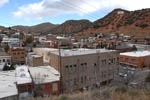 My first glimpse of Bisbee made the trip worthwhile. The town is in
the mountains, and the historic district lines a north/south canyon.
There's one main street through town, with smaller streets crawling
into the hills and ending abruptly. Most of the downtown buildings
date back to the glory days of the late 19th and early 20th century,
with signs of recent renovations amid a hundred years of
deterioration.
My first glimpse of Bisbee made the trip worthwhile. The town is in
the mountains, and the historic district lines a north/south canyon.
There's one main street through town, with smaller streets crawling
into the hills and ending abruptly. Most of the downtown buildings
date back to the glory days of the late 19th and early 20th century,
with signs of recent renovations amid a hundred years of
deterioration.
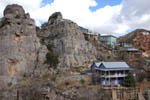
That may sound grim, which I assure you the place is not. True, it
was windy and chilly and kind of overcast when I arrived, but it
didn't take long to start discovering Bisbee's charm. Like that
hippie influence I mentioned, which certainly shows in the color
choices of some of the homes. Although given the precarious locations
of those homes, I hope the owners are more professional in their
maintenance activities than I generally associate with the hippie era.
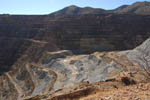 Heading south of town I got a glimpse into the world of large scale
mining, as well as what happens when the scale goes abruptly from
large to N gauge. Bisbee is the only place I've been where a Scenic
Overlook sign guides you to views of a large manmade hole in the
Heading south of town I got a glimpse into the world of large scale
mining, as well as what happens when the scale goes abruptly from
large to N gauge. Bisbee is the only place I've been where a Scenic
Overlook sign guides you to views of a large manmade hole in the
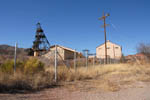 ground. Impressive, if hardly as stirring a sight as that
rather larger hole to the north.
There are plenty of remnants around town from both the
underground and open pit mining years, as you'd expect after nearly a
century of digging. They run tours of one of the underground mines,
guided by former miners. Of course, as one of the locals pointed out,
that won't go on much longer. Thirty years after the last of the
closures, there aren't that many former miners left in Bisbee to
describe the work and the life. My advice is to see it while you can.
ground. Impressive, if hardly as stirring a sight as that
rather larger hole to the north.
There are plenty of remnants around town from both the
underground and open pit mining years, as you'd expect after nearly a
century of digging. They run tours of one of the underground mines,
guided by former miners. Of course, as one of the locals pointed out,
that won't go on much longer. Thirty years after the last of the
closures, there aren't that many former miners left in Bisbee to
describe the work and the life. My advice is to see it while you can.
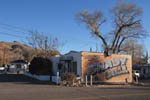 One of the problems of the way I plan trips is that I only learn what
I should have done after it's too late. Case in point: my choice of
lodging, which I allowed to be dictated by the choices offered by
Orbitz and
Travelocity. I learned the
error of my ways after meeting Joy, proprietress of a
One of the problems of the way I plan trips is that I only learn what
I should have done after it's too late. Case in point: my choice of
lodging, which I allowed to be dictated by the choices offered by
Orbitz and
Travelocity. I learned the
error of my ways after meeting Joy, proprietress of a
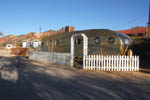 rather spectacular B&B in
town. In addition to telling me how I screwed up in picking an
anonymous motel outside town (with, by the way, free WiFi which was
both wireless and mostly reliability-less), Joy clued me in to the
history and rhythms of the town. She also took her guests and me on a
tour of spots I'd never have visited on my own, like the local
cemetery, and the
Shady Dell Trailer Park,
where I might have stayed
in a grand old trailer from before I was born. Or at least not much
after. The lesson being that to properly experience a place, you need
to either know what you're doing or put yourself in the hands of
someone who does. Which so isn't me, y'know?
rather spectacular B&B in
town. In addition to telling me how I screwed up in picking an
anonymous motel outside town (with, by the way, free WiFi which was
both wireless and mostly reliability-less), Joy clued me in to the
history and rhythms of the town. She also took her guests and me on a
tour of spots I'd never have visited on my own, like the local
cemetery, and the
Shady Dell Trailer Park,
where I might have stayed
in a grand old trailer from before I was born. Or at least not much
after. The lesson being that to properly experience a place, you need
to either know what you're doing or put yourself in the hands of
someone who does. Which so isn't me, y'know?